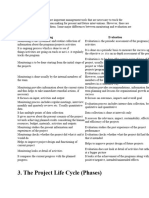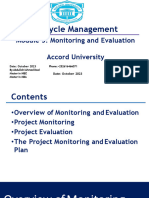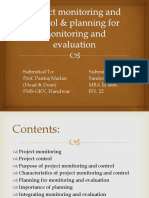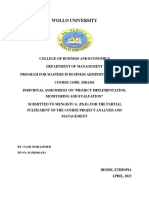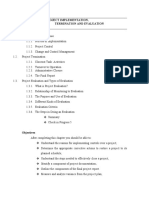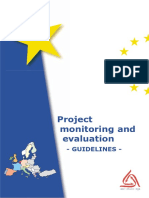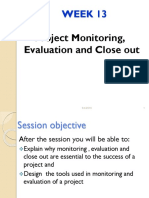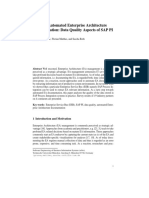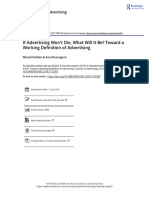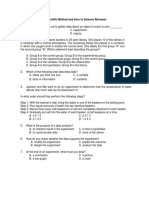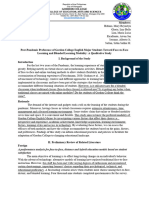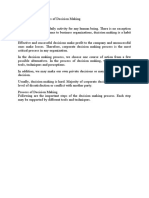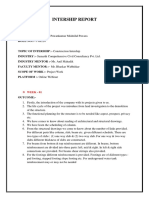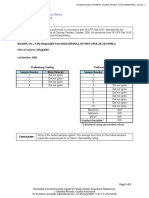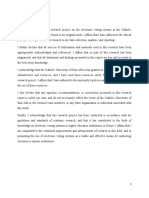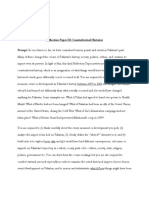SOCI 202 Community Development and Social Welfare
Topic 5. Processes of Community Development
(Implementation, Monitoring and Evaluation)
So far, we have looked at the initial processes involved in the community development process.
Today we shall discuss two of the last processes that include the implementation of program or
project activities as well as the importance of the project monitoring and evaluation processes.
A project is a temporary endeavor designed to produce a unique product, service or result with a
defined beginning and end (usually time- constrained, and often constrained by funding or
deliverables) undertaken to meet unique goals and objectives, typically to bring about beneficial
change or added value.
The temporary nature of projects stands in contrast with business as usual (or operations), which
are repetitive, permanent, or semi-permanent functional activities to produce products or services.
In practice, the management of these two systems is often quite different, and as such requires the
development of distinct technical skills and management strategies.
Projects may be audited or reviewed while the project is in progress. Formal audits are generally
risk or compliance-based and management will direct the objectives of the audit. An examination
may include a comparison of approved project management processes with how the project is
actually being managed. Each project should be assessed for the appropriate level of control
needed: too much control is too time consuming, too little control is very risky. If project control
is not implemented correctly, the cost to the business should be clarified in terms of errors and
fixes.
Implementation.
Overall, the following processes and activities are core at the implementation phase of any
community development initiative or drive. Development workers and change agents ought to:
• Carry out the project plan according to the schedule.
• Manage project team members and assign tasks.
• Communicate with stakeholders regularly.
• Address and manage changes to the project scope.
1
� • Monitor and control project progress and quality.
• Perform procurement activities as outlined in the plan.
• Address and mitigate project risks as they arise.
Monitoring, Control and Evaluation
During the implementation phase, monitoring and evaluation are important processes that are
embedded throughout the planning and implementation cycle of any community development
initiative or program.
Monitoring is a deliberate systematic means of collection and analysis of information as a
project progresses which is intended at knowing the adequate efficiency and effectiveness of a
project embarked on with thorough use of resources. It facilitates organizations to determine
whether the resources available are enough and are being utilized satisfactorily.
Project monitoring is establishing the measure that projects are on targets and indicators to
measure advancement and achievement.
Evaluation involves conscious checking into project effects vis-à-vis the agreed slated plans on
accomplishment scale. Its concerned with outcome process of a blueprint which can be done
during and after the project. Evaluation is not an end product but a process expected to take
place throughout the stages of a project or action. Evaluation is a process used to ascertain
what has happened during a given activity, whether a programme or activity is working, and
whether the initial commitment has been carried out and achieved. In the course of the project
it is done to ensure any contingency that can hamper the project is resolved and plans are
amended to suit goals of the project.
Project evaluation is aimed at understanding success or failure, while at the same time outline the
means, measure and mediums for improvement ahead of next implementation of project plan.
Key differences distinguish the processes of monitoring and evaluation as outlined in the table
below;
2
� Indices of variation Monitoring Evaluation
Continuous, throughout Periodic review at significant points
Timing the project in the project progress
Day to day activities, output, Access overall delivery of outputs
Scope indicators of progress and and progress towards objectives and
change goals
Project staff, project users External evaluators, facilitators, project
Main participants users, project staff, sponsors
Regular meetings, interviews, Extraordinary meeting, additional
Process monthly, quarterly reviews data collection exercise etc.
Regular reports and updates Written report with recommendations
Written output to project users, management for changes to project- presented in
and sponsors workshops to different stakeholder
Government agencies, Stakeholders, top-management team,
researchers, companies external facilitator’s, staff etc.
Information users
Translates objectives into Examines implementation process
Intent performance indicators a n d for better significant accomplishment
s e t targets vis-à-vis offers recommendations for
improvement on slated project
Activities are linked with Activities assess specific contribution
resources to aligned with of project in relations to result
Activities objectives
Monitoring and controlling includes:
1. Measuring the ongoing project activities ('where we are');
2. Monitoring the project variables (cost, effort, scope, etc.) against the project management
plan and the project performance baseline (where we should be);
3. Identifying corrective actions to address issues and risks properly (How can we get on
track again);
4. Influencing the factors that could circumvent integrated change control so only approved
changes are implemented.
5. In multi-phase projects, the monitoring and control process also provides feedback
between project phases, in order to implement corrective or preventive actions to bring
the project into compliance with the project management plan.
Here, in considering the processes of monitoring, controlling and evaluation, the change agents
pay particular attention to ensure that he/she;
3
�• Continuously tracks and measures project performance against the project plan.
• Uses key performance indicators (KPIs) to assess progress.
• Identifies variances and take corrective actions to stay on track.
• Ensures quality control through inspections and testing.
• Manages scope changes through a formal change control process.
• Monitors and manage project risks and issues.
• Updates project documentation as needed.
• Ensures that all project objectives and deliverables are met.
• Conducts a final review and quality assessment.
• Release project resources and close procurement contracts.
• Create a project closure report.
• Conduct a lesson learned session to capture insights for future projects.
• Complete all project-related administrative tasks, including financial and
contractual closeout.
